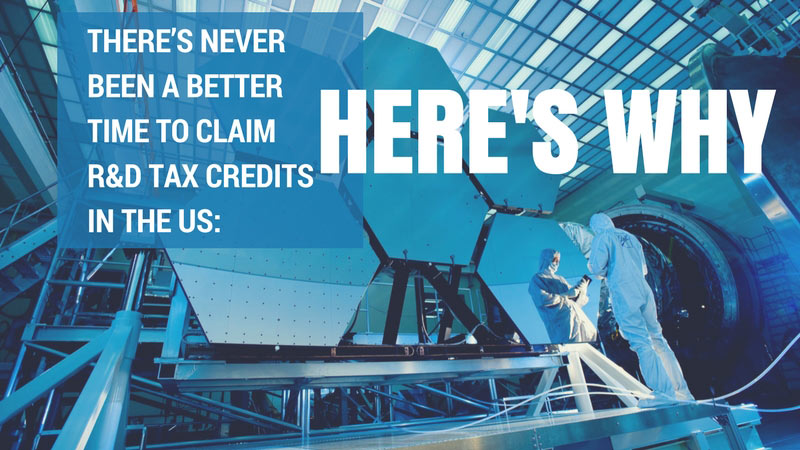New businesses or start-up companies in the USA may be eligible to apply the R&D tax credit against their payroll taxes for up to five years.
What companies in the USA qualify for the offset?
The new payroll-tax offset allows companies to receive a benefit for research activities even if they aren’t profitable. To be eligible for the credit, companies must meet these qualifications:
- Gross receipts for five years or less (interest income counts toward gross receipts)
- Less than $5 million in gross receipts in the year the credit is elected
- Qualifying research activities and expenditures
- Payroll-tax liability
What are qualifying activities?
Regardless of industry, companies are potentially eligible for the USA R&D credit if their activities meet the following requirements, known as the four-part test:
- Technological uncertainty. The activity is performed to eliminate technological uncertainty about the development or improvement of a product or process, which includes computer software, techniques, formulas, and inventions.
- Process of experimentation. The activities include some process of experimentation undertaken to eliminate or resolve a technical uncertainty. This process involves an evaluation of alternative solutions or approaches and is performed through modeling, simulation, systematic trial and error, or other methods.
- Technological in nature. The process of experimentation relies on the hard sciences, such as engineering, physics, chemistry, biology, or computer science.
- Qualified purpose. The purpose of the activity must be to create a new or improved product or process, including computer software, that results in increased performance, function, reliability, or quality.
Additional thresholds may apply if a company develops software for internal use. Additionally, activities must be performed in the USA and can’t be funded by another party.
What are eligible R&D expenditures?
Eligible R&D costs include these categories:
- Wages. W-2 taxable wages for employees offering direct support and first-level research supervision.
- Supplies. Supplies used in research, including so-called extraordinary utilities but not capital items or general administrative supplies.
- Contract research. Certain subcontractor expenses if the subcontractor’s tasks would qualify if they were instead being performed by an employee. These can include labor, services, or research, but payment can’t be contingent on results. In addition, the taxpayer must retain substantial rights in the results, whether exclusive or shared.
- Rental or lease costs of computers. This could include payments made to cloud service providers for the cost of renting server space, as longs as payments are related to hosting software under development versus payments for hosting a stable software release.
What are some potential benefits of the offset?
Brand-new businesses can potentially claim the credit for up to five years with a maximum of $1.25 million in total credits claimed on their quarterly federal payroll tax returns.
New businesses and start-up companies will see a benefit between 6% and 14% of their eligible R&D costs. For most companies that incur at least $300,000 in eligible R&D costs, the federal credit to offset payroll tax will be equal to 10% of total R&D expenses.
For example, a company with $500,000 of eligible expenses—let’s say engineering costs—could receive a $50,000 credit. On the other hand, a company with over $2.5 million in eligible expenses could receive a credit equal to the full $250,000 annual limitation.
If the amount of the credit exceeds a company’s Social Security tax—also known as the OASDI tax—liability in any given quarter, the excess can be carried forward to the next calendar quarter.
Social Security Tax
The payroll-tax offset can only be applied to the Social Security portion of payroll taxes. Companies are required to pay Social Security tax of 6.2% on up to $127,200 of each employee’s salary. For example, a company that employs 50 employees with an average salary of $75,000 would pay approximately $232,500 in Social Security payroll taxes.
Accordingly, a company would need to have more than $4 million in annual payroll subject to Social Security tax and $2.5 million in eligible R&D costs to offset the maximum $250,000 in payroll taxes each year under the new law.
Most employers are required to deposit their payroll taxes to the federal government on a monthly or semiweekly basis as well as file a quarterly payroll tax return via Form 941. However, the credit will be applied against the Social Security tax on the quarterly return—not when it’s deposited monthly or semiweekly.
What should companies know about documentation?
It’s important companies have the right documentation in place. It’s also key to know there isn’t a one-size-fits-all approach to documentation. The level of documentation deemed to be adequate varies based on the size and scope of the credit amounts claimed.
Companies should expect a greater time commitment to get set up in the first year of claiming an R&D credit. They’ll also need to put the appropriate measures in place to completely use the credit going forward. Depending on the company, it’s possible any historic R&D spending incurred may need to be evaluated.
Proving Nexus
Taxpayers often will need to provide a nexus between their R&D expenses and qualified research activities. This can be challenging—even for companies that have some level of project tracking in place. This is because time- and expense-tracking systems aren’t generally intended to track eligible R&D expense to business components or R&D activities.
The subjectivity and interpretation of the R&D rules make it difficult to develop the perfect software tool for tracking eligible expenses and documentation, particularly when considering annual updates to tax law, regulations, and IRS guidance. For this reason, it’s important to note project-accounting and time-tracking systems aren’t a prerequisite to claim the R&D credit.
Meeting the Four-Part Test
At minimum, taxpayers’ qualitative documentation should demonstrate how their underlying activities meet the four-part test. Examples of adequate documentation can vary by industry, but it’s possible for companies to leverage documentation they generate in their day-to-day operations. Qualitative documentation may also require review and analysis of any contracts between companies and their customers, partners, or vendors.
The payroll-tax offset is available to eligible new businesses and start-up companies for up to five years. Any unused R&D credits that aren’t elected to offset payroll taxes may be carried forward for up to 20 years and used when the business becomes profitable. This length of time makes thorough documentation even more important.
We’re Here to Help
To learn more about the R&D payroll-tax offset, whether your business qualifies, or our other R&D tax services, contact Pinnacle today!



Share This Article
Choose Your Platform: Facebook Twitter Google Plus